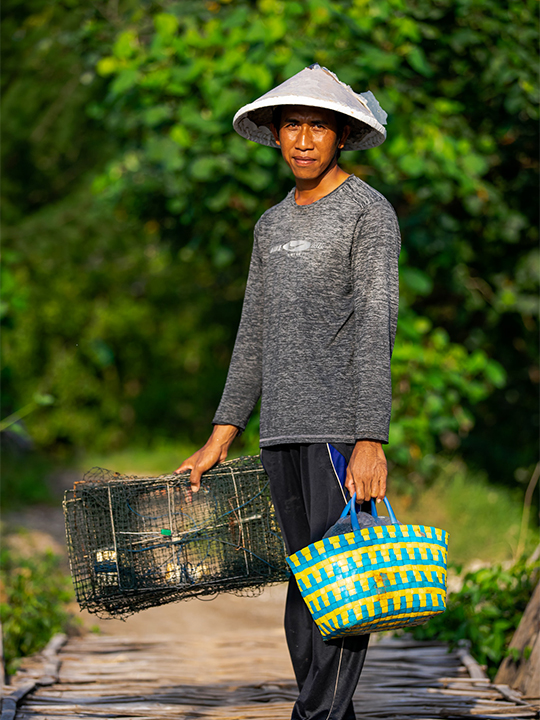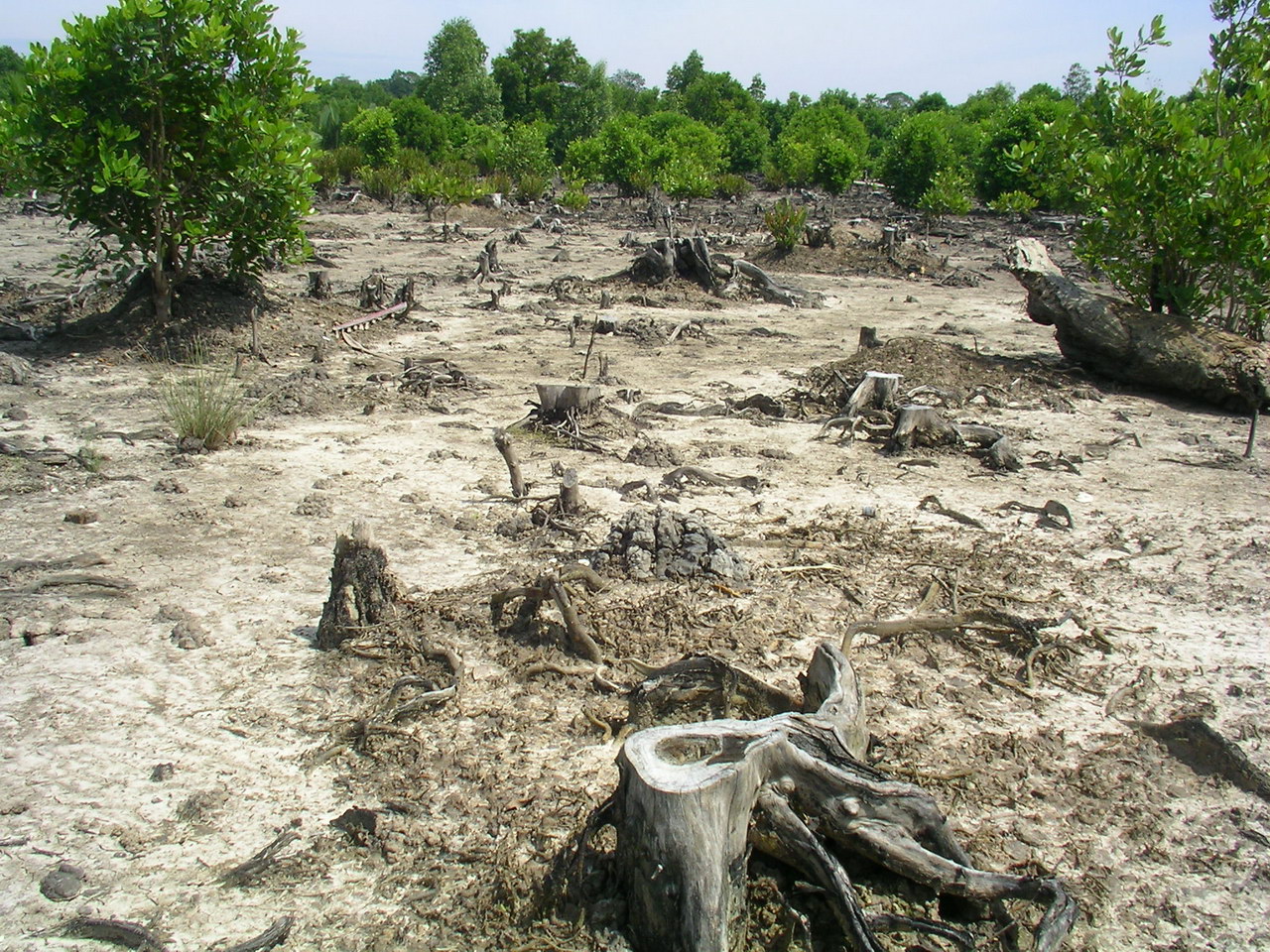- Indonesia has more mangrove forests than any other country, but much of it has been degraded for fish and shrimp farms.
- The government aims to restore 600,000 hectares of mangroves by 2024, but questions remain about its stated progress toward that goal.
- If Indonesia can completely stop mangrove destruction, it can meet one-fourth of the government’s 29% emissions reduction target for 2030.
In the Indonesian village of Kun-kun, where illegal loggers once cut mangroves for timber, a new livelihood has come to the fore: crab fishing.
“Without the mangroves, the crabs cannot grow well,” said villager Roslina, 50. “It has been a perfect habitat for crabs to live, together with other various fish and shrimp.”
Roslina leads a government-sanctioned forest farmers group in Kun-kun, in northern Sumatra near the island’s Indian Ocean coast.
Her story was recounted in a government pamphlet about the group, which has received training from the Ministry of Environment and Forestry on how to raise mangrove crabs under a program funded by the World Bank and the Danish government.
Kun-kun is one example of how protecting mangroves can benefit local livelihoods. But it’s only one bright spot in Indonesia, which has more mangroves than any other country but whose mangroves are mostly degraded, according to government figures.

Mangroves absorb more carbon per hectare than inland forests, making them particularly important in the fight against climate change. Indonesia has pledged to reduce its carbon emissions by 29% by 2030, independently, from a 2010 base year, or by 41% with international assistance.
Mangroves also yield forest products and wild fish and serve as buffers to protect coastlines against extreme weather events like tsunamis.
Despite these benefits, much of Indonesia’s mangroves have been cleared to make way for fish farming.
In Gorontalo province on the island of Sulawesi, for example, more than 90% of the mangroves in the Tanjung Panjang Nature Reserve have been illegally cleared to make way for shrimp and fish ponds, according to Nurain Lapolo, director of the Advocacy Network for Natural Resources Management (JAPESDA), a local conservation group.
“The government’s neglect and inconsistent zoning has enabled widespread encroachment,” she told Mongabay.
After much damage, the government has tightened regulations in the area. Mangrove rehabilitation efforts still take place, but the lack of a sense of belonging in the rehabilitation program among the community has impeded these efforts, Nurain said.
According to the Center for International Forestry Research (CIFOR), Indonesia loses 52,000 hectares (128,500 acres) of mangroves every year, an area larger than New York City. Some 40% of the country’s mangroves have disappeared in the past 30 years.
Indonesian mangrove destruction emits 190 million metric tons of carbon dioxide equivalent annually, according to CIFOR. This amounts to 42% of global annual emissions from coastal ecosystem damage.
If Indonesia can completely stop mangrove destruction, it can meet one-fourth of the government’s 29% emissions reduction target for 2030. That’s the equivalent of taking 40 million cars off the roads, CIFOR calculates.

A 2012 presidential regulation created the National Strategy for Mangrove Ecosystem Management. The regulation established a multisectoral national mangrove working group, Kelompok Kerja Mangrove Nasional (KKMN), to operate the strategy. However, the working group is underfunded and undermanaged, according to its secretary in a 2018 discussion, and has been unable to coordinate the differing sectors.
Hartono Prawiratmadja, the head of the Peatland and Mangrove Restoration Agency (BRGM), said earlier this year that the agency’s target of restoring 600,000 hectares (1.48 million acres) of mangroves by 2024 was achievable.
He said the agency’s 2021 rehabilitation target of 30,000 hectares (74,100 acres) had been surpassed when the agency recorded 34,911 hectares (86,267 acres) restored. He didn’t say how large an area of mangroves had been damaged in 2021.
Mongabay contacted the BRGM chief by WhatsApp to ask how the surpassed target figure has been verified and how the extent of damaged mangroves was detected in 2021. Hartono did not reply.
A webinar in May on mangrove rehabilitation discussed the challenges on the ground. The success rate in planting models was low for seedlings not being planted in the proper place, said Rio Ahmad, director of the Blue Forests Foundation, a local conservation group.
“Mangroves are often forced to grow in a level muddy field,” he said. “Usually they are planted below the seawater level, a place where mangroves cannot grow.”
In an interview with Mongabay, Rio was asked to comment on the probable success rate of the BRGM’s stated 2021 achievement.
“We do not know the evaluation results or the mangrove survival rate of BRGM’s mangrove planting program in 2021. An official release from the BRGM is required or from some other mandatory party related to the matter,” Rio said.
He did, however, list six principles to be heeded that support successful mangrove rehab.
First, understand the landscape history and condition where rehabilitation is to take place. If the rehabilitation location was not previously a mangrove area, the rate of failure would be greater.
Second, observe the disturbances and inhibiting factors for the natural regeneration of mangroves. Before any rehabilitation work, overcome limiting factors like the hydrology and seedling availability, Rio said.

Abu Bakar Sidik Katili, a biology researcher at Gorontalo State University, spelled out the location criteria where mangroves can be best planted.
“The location to choose to plant mangroves is that the land is clear and clean, meaning it is problem-free and clearly has state land status,” he told Mongabay.
Other criteria are that the location must have the agreement of all parties concerned. It requires human intervention in that no natural regeneration can occur, and that there is no potential for future land use change.
“An example [for an appropriate planting site] is open land, heavily degraded forest on both banks of a river, a pond. Other locations must have muddy soil and are affected by the tides,” Katili said.
A 2017 regulation for mangrove management from the office of the coordinating minister for economic affairs targets 3.49 million hectares (8.62 million acres) of good mangrove cover by 2045.
Indonesia wants to restore all damaged sites and maintain mangroves in good condition by 2045, the nation’s independence centennial.
One measure of success is when hundreds, if not thousands, of Roslinas emerge throughout the archipelago to protect and benefit from their village mangroves.
“Our crab supply sometimes cannot meet high demand,” Roslina said. “The market is there waiting for us.”
Banner image: Mangroves in Raja Ampat, Indonesia. Image by The Ocean Agency / Ocean Image Bank.
